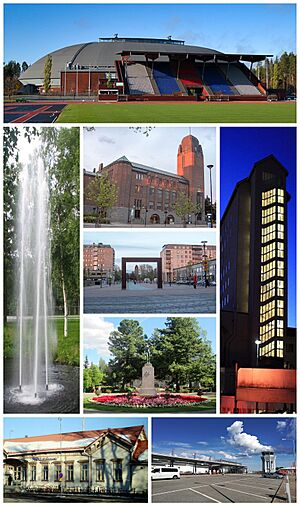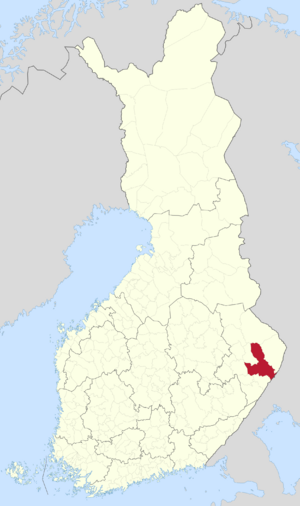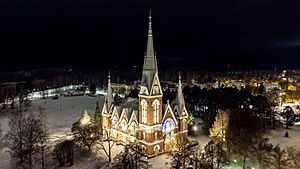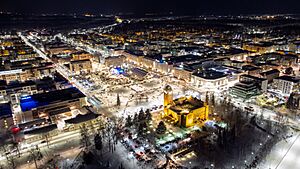Joensuu facts for kids
Quick facts for kids
Joensuu
Jovensuu (Karelian)
|
|||
|---|---|---|---|
|
City
|
|||
| Joensuun kaupunki Joensuu stad City of Joensuu |
|||

Clockwise from top-left: the Joensuu Arena, the North Karelia Central Hospital, the Joensuu Airport, the Joensuu Railway Station, and the fountain in the park; in the middle from top to bottom: the Joensuu City Hall, The Gate of Joensuu (Joensuun portti) near the market square, and the Statue of Liberty in the Park of Liberty
|
|||
|
|||
| Nickname(s):
Jönssi, Jenssi
|
|||

Location of Joensuu in Finland
|
|||
| Country | |||
| Region | |||
| Sub-region | Joensuu | ||
| Charter | 1848 | ||
| Area
(2018-01-01)
|
|||
| • Total | 2,751.07 km2 (1,062.19 sq mi) | ||
| • Land | 2,381.79 km2 (919.61 sq mi) | ||
| • Water | 369.31 km2 (142.59 sq mi) | ||
| Area rank | 26th largest in Finland | ||
| Population
(2023-12-31)
|
|||
| • Total | 78,062 | ||
| • Rank | 12th largest in Finland | ||
| • Density | 32.77/km2 (84.9/sq mi) | ||
| Population by native language | |||
| • Finnish | 92.5% (official) | ||
| • Swedish | 0.1% | ||
| • Others | 7.4% | ||
| Population by age | |||
| • 0 to 14 | 13.5% | ||
| • 15 to 64 | 64.1% | ||
| • 65 or older | 22.5% | ||
| Time zone | UTC+02:00 (EET) | ||
| • Summer (DST) | UTC+03:00 (EEST) | ||
| Unemployment rate | 14.5% | ||
Joensuu is a city in Finland. It is the main city of the North Karelia region. The name "Joensuu" means "river's mouth" in Finnish. The city is in eastern Finland, near many lakes. About 78,000 people live in Joensuu. It is one of the biggest cities in Finland.
Joensuu was started in 1848 by Emperor Nicholas I of Russia. It sits on the northern shore of Lake Pyhäselkä, which is part of the large Lake Saimaa system. The River Pielinen flows into this lake here. The city of Kuopio is about 136 km (85 miles) to the west. Joensuu is a major center for business and culture in Eastern Finland. It is also a big student city. The University of Eastern Finland has a campus here with over 20,000 students. The Karelia University of Applied Sciences also has about 4,000 students.
Contents
- What is the Joensuu Coat of Arms?
- What is the History of Joensuu?
- What is the Geography of Joensuu?
- Who Lives in Joensuu?
- What is the Economy of Joensuu like?
- How do People Travel in Joensuu?
- What Sports are Popular in Joensuu?
- What Educational Opportunities are in Joensuu?
- Who are Some Famous People from Joensuu?
- What are Joensuu's Friendship Cities?
- Images for kids
- See also
What is the Joensuu Coat of Arms?
The coat of arms of Joensuu has a special design. It shows a shield with two parts. The top part looks like a moat, and the bottom part has a wavy line. The colors are red, silver, and black.
The wavy line stands for the Pielinen River that flows through the city. The moat shape shows that Joensuu is close to Finland's eastern border. The colors black and red are common colors for the Karelia region. Toivo Vuorela designed this coat of arms in 1957. The city also has a flag that looks like the coat of arms, but with white instead of silver.
What is the History of Joensuu?
Joensuu was founded in 1848 by Czar Nicholas I. In the 1800s, it became a city known for making and selling goods. In 1860, the city was allowed to trade freely. This helped local sawmills grow a lot.
Water travel became easier when the Saimaa Canal opened in 1856. This allowed busy trade between North Karelia, St. Petersburg, and Central Europe. By the late 1800s, Joensuu was one of Finland's biggest harbor cities.
The Pielisjoki River has always been important to the city. Canals built by 1870 made river traffic even busier. Many steamboats, barges, and logging boats used the river. The river was also a key route for floating logs to sawmills.
Over the past few decades, Joensuu has grown from a small farming town into a lively city. It grew by joining with nearby towns. Also, investing in education, like building the university, helped the city become stronger.
Several nearby areas have joined Joensuu over time. Pielisensuu joined in 1954. In 2005, Kiihtelysvaara and Tuupovaara became part of Joensuu. Then, in 2009, Eno and Pyhäselkä also joined. After these changes, the Joensuu area now has about 73,000 people.
The University of Joensuu (now part of the University of Eastern Finland) has grown a lot. It is very important for the city's success. The university works with other countries in science and business. This helps the whole region.
Being close to the eastern border has shaped Joensuu's history. The Republic of Karelia in Russia is an important partner for trade. Companies in Joensuu continue old traditions of foreign trade.
Joensuu also has many cultural events. These include the Ilosaarirock music festival, Joensuu Music Winter, and Gospel festivals. These events make the city an attractive place to visit. Joensuu is sometimes called the "Forest Capital of Europe." This is because the European Forest Institute and other forestry research centers are located there.
What is the Geography of Joensuu?
Joensuu is surrounded by other towns. These include Liperi, Kontiolahti, Lieksa, Ilomantsi, Tohmajärvi, and Rääkkylä. Joensuu is also part of the Joensuu sub-region. This region includes other towns like Heinävesi, Juuka, and Outokumpu.
What is the Climate like in Joensuu?
Joensuu has a cold climate with long, snowy winters. Summers are short but can be warm. It is far from the sea, so temperatures can be very hot or very cold.
The highest temperature ever recorded in Joensuu was 37.2 °C (99.0 °F) in July 2010. This is the highest temperature ever recorded in Finland. The lowest temperature was -40.0 °C (-40.0 °F) in December 1955. In winter, there is usually a lot of snow, about 50–70 cm (20–28 inches) deep. It snows for about 225 mm (8.9 inches) each year.
| Climate data for Joensuu (1991–2020, extremes 1955–present) | |||||||||||||
|---|---|---|---|---|---|---|---|---|---|---|---|---|---|
| Month | Jan | Feb | Mar | Apr | May | Jun | Jul | Aug | Sep | Oct | Nov | Dec | Year |
| Record high °C (°F) | 6.7 (44.1) |
7.8 (46.0) |
12.8 (55.0) |
23.5 (74.3) |
29.2 (84.6) |
32.0 (89.6) |
37.2 (99.0) |
31.4 (88.5) |
25.8 (78.4) |
18.7 (65.7) |
10.5 (50.9) |
8.3 (46.9) |
37.2 (99.0) |
| Mean maximum °C (°F) | 2.8 (37.0) |
2.4 (36.3) |
6.6 (43.9) |
15.0 (59.0) |
23.6 (74.5) |
26.7 (80.1) |
28.1 (82.6) |
25.8 (78.4) |
20.1 (68.2) |
12.5 (54.5) |
7.1 (44.8) |
3.3 (37.9) |
29.2 (84.6) |
| Mean daily maximum °C (°F) | −5.6 (21.9) |
−5.4 (22.3) |
−0.1 (31.8) |
6.3 (43.3) |
13.9 (57.0) |
19.0 (66.2) |
21.9 (71.4) |
19.4 (66.9) |
13.4 (56.1) |
6.0 (42.8) |
0.4 (32.7) |
−3.1 (26.4) |
7.2 (45.0) |
| Daily mean °C (°F) | −8.6 (16.5) |
−8.6 (16.5) |
−4.0 (24.8) |
2.0 (35.6) |
9.0 (48.2) |
14.3 (57.7) |
17.3 (63.1) |
15.1 (59.2) |
9.8 (49.6) |
3.6 (38.5) |
−1.6 (29.1) |
−5.5 (22.1) |
3.6 (38.5) |
| Mean daily minimum °C (°F) | −12 (10) |
−12.2 (10.0) |
−8.1 (17.4) |
−2.3 (27.9) |
3.5 (38.3) |
9.3 (48.7) |
12.5 (54.5) |
10.8 (51.4) |
6.3 (43.3) |
1.0 (33.8) |
−3.9 (25.0) |
−8.4 (16.9) |
−0.3 (31.5) |
| Mean minimum °C (°F) | −26.8 (−16.2) |
−25.3 (−13.5) |
−19.0 (−2.2) |
−11.2 (11.8) |
−3.9 (25.0) |
2.3 (36.1) |
6.7 (44.1) |
4.7 (40.5) |
−0.9 (30.4) |
−7.5 (18.5) |
−14.7 (5.5) |
−22.0 (−7.6) |
−29.5 (−21.1) |
| Record low °C (°F) | −39.0 (−38.2) |
−38.5 (−37.3) |
−32.1 (−25.8) |
−21.4 (−6.5) |
−10.5 (13.1) |
−4.2 (24.4) |
2.2 (36.0) |
−1.7 (28.9) |
−7.2 (19.0) |
−16.8 (1.8) |
−27.3 (−17.1) |
−40.0 (−40.0) |
−40.0 (−40.0) |
| Average precipitation mm (inches) | 45 (1.8) |
37 (1.5) |
33 (1.3) |
30 (1.2) |
44 (1.7) |
64 (2.5) |
66 (2.6) |
73 (2.9) |
57 (2.2) |
60 (2.4) |
53 (2.1) |
54 (2.1) |
616 (24.3) |
| Average precipitation days (≥ 0.1 mm) | 21 | 17 | 14 | 12 | 12 | 15 | 15 | 16 | 16 | 18 | 20 | 21 | 197 |
| Source: FMI (Temperature data for Liperi Airport elevation 121 m, precipitation Joensuu Pyhäselkä elevation 79 m) | |||||||||||||
Who Lives in Joensuu?
The city of Joensuu has about 78,062 people. Most people in Joensuu speak Finnish. About 92.5% of the population speaks Finnish as their first language.
Population by mother tongue (2023) Finnish (92.5%) Russian (3.4%) Arabic (0.4%) English (0.4%) Ukrainian (0.3%) Chinese (0.2%) Other (2.8%)
Many different languages are spoken in Joensuu. The most common foreign languages are Russian, Arabic, English, and Ukrainian. Even though Finnish is the main language, many people also know English or Swedish from school.
How Diverse is Joensuu's Population?
In 2023, about 7.5% of the people in Joensuu had a background from another country. This means they or their parents were born outside Finland. Most foreign-born people came from the former Soviet Union, Russia, Sweden, and Bangladesh. The number of new residents from other countries is growing.
What Religions are Practiced in Joensuu?
In 2023, the largest religious group in Joensuu was the Evangelical Lutheran Church of Finland. About 62.8% of the people belonged to this church. Other religious groups made up 6.2% of the population. About 31.0% of the people did not have a religious affiliation.
What is the Economy of Joensuu like?
Joensuu is a growing city with many service businesses. Many companies that work with information and communication technology are located in the Joensuu Science Park. Big industrial companies include Abloy Oy, which makes locks, and John Deere, which makes forest machines.
Research and new product development happen at the university and science park. They work on things like color research and optics. Some of the companies that pay the most taxes in Joensuu include Broman Group Oy (car parts) and Assa Abloy Oy (locks).
The biggest employers in Joensuu are the City of Joensuu itself, the North Karelia Hospital District, and the University of Joensuu. Other large employers include Abloy Oy and the North Karelia Education Consortium.
There are four shopping centers in Joensuu. These are Iso Myy, Metropol, Plaza Centrum, and a department store called Sokos.
How do People Travel in Joensuu?
Joensuu has a train station and a bus station. You can take trains and buses to other cities like Helsinki. There are also local bus services within Joensuu. The city has an airport nearby in Liperi, with flights to Helsinki.
Joensuu is also on the Blue Highway. This is a special tourist route that goes from Norway, through Sweden, and into Russia.
What Sports are Popular in Joensuu?
Joensuu is known for its basketball team, Kataja. They play in Finland's top league. Other professional sports teams include Josba (for floorball) and Karelian Hurmos (for volleyball). The ice hockey team, Joensuun Kiekko-Pojat, plays in the second-highest league. Their home is the Mehtimäki Ice Hall.
The local football team, JIPPO, plays in the second-highest level of Finnish football. Finnish baseball is also very popular. The local team, Joensuun Maila, plays in the top division.
Many famous athletes are from Joensuu. These include Jukka Keskisalo, a European champion in steeplechase. Aki Parviainen is a world champion in javelin throwing. Kaisa Mäkäräinen is a biathlete who won three World Cup titles. Other notable athletes include rally drivers Hannu Mikkola and Toomas Heikkinen, and ice hockey players Urho Vaakanainen and Juuso Riikola.
What Educational Opportunities are in Joensuu?
Joensuu is a city with many students. The University of Eastern Finland has one of its main campuses here. The University of Applied Sciences Karelia also has two campuses in Joensuu.
There are five high schools in Joensuu:
- Lyceum High School
- Upper Secondary Normal School
- Joensuu Coeducational High School
- Finnish-Russian Upper Secondary School of the Eastern Finland
- Pyhäselkä High School
Joensuu also has a Sports Academy. This program helps young athletes get training and coaching while they study.
Who are Some Famous People from Joensuu?
- Ismo Alanko (born 1960), a musician
- Toomas Heikkinen (born 1991), a racing driver
- Floor Jansen, a Dutch singer from the band Nightwish, lived in Joensuu for a time.
- Aku Korhonen (1892−1960), an actor
- Matias Laine (born 1990), a racing driver
- Suvi Lindén (born 1962), a politician and former Minister of Culture
- Kaisa Mäkäräinen (born 1983), a famous biathlete
- Hannu Mikkola (1942–2021), a rally driver
- Esa Pakarinen (1911–1989), an actor and singer
- Pentti Saarikoski (1937–1983), a poet
- Urho Vaakanainen (born 1999), an ice hockey player
What are Joensuu's Friendship Cities?
Joensuu has friendship agreements with several cities around the world:
 Linköping, Sweden (since 1940)
Linköping, Sweden (since 1940) Ísafjörður, Iceland (since 1948)
Ísafjörður, Iceland (since 1948) Tønsberg, Norway (1948)
Tønsberg, Norway (1948) Hof, Germany (since 1970)
Hof, Germany (since 1970) Vilnius, Lithuania (since 1970)
Vilnius, Lithuania (since 1970) Petrozavodsk, Russia (since 1994)
Petrozavodsk, Russia (since 1994)
Images for kids
See also
 In Spanish: Joensuu para niños
In Spanish: Joensuu para niños










